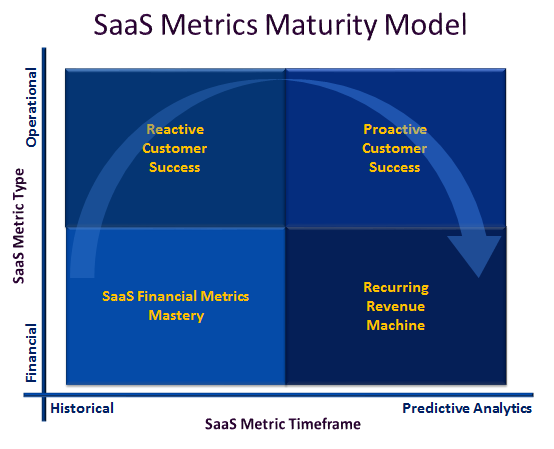Becoming a Metrics-driven SaaS Business is no easy task. It takes time, commitment and plenty of customers. However, the financial rewards of moving beyond standard SaaS financial metrics to SaaS customer success metrics and ultimately to sophisticated predictive analytics are significant. Each step toward SaaS metrics greatness builds upon the last. The stages of development can be classified into a natural progression of increasing SaaS business understanding from financial stability to operational measurability to revenue predictability outlined at the very beginning of this series. These stages define a SaaS Metrics Maturity Model that provides a SaaS metrics roadmap along with benchmarks at each stage of development for SaaS companies that aspire to become a Metrics-driven SaaS Business.

The SaaS Metrics Maturity model provides a SaaS metrics roadmap
along with benchmarks at each stage of development
for SaaS companies that aspire to become a Metrics-driven SaaS Business.
This is the fourth and final post in a series inspired by my ongoing collaboration with Bluenose Analytics that explores the new Metrics-driven SaaS Business based on emerging best practices in SaaS customer success metrics. The last two posts discussed the potential uses of SaaS customer success metrics for reducing churn and accelerating customer acquisition. This final post defines The SaaS Metrics Maturity Model, a path for SaaS companies to follow on their way to becoming a Metrics-driven SaaS business.
SaaS Metrics Maturity Model Stage 1:
SaaS Financial Metrics Mastery
The first step along the path to becoming a Metrics-driven SaaS Business occurs when a SaaS business achieves a stable SaaS business model that allows management to monitor the key SaaS financial metrics, including recurring revenue, customer acquisition cost, churn, growth and cost of service. Financial plans and targets are produced using these now standard financial metrics. In addition to the basic financial metrics, more advance metrics such as the customer lifetime value, churn cohorts and the various SaaS magic numbers may also be calculated.
The stage one SaaS business has a solid understanding of SaaS economics grounded in SaaS financial metrics. As the use of SaaS metrics becomes the company standard, they are pushed out into departmental plans. Sales is compensated on recurring revenue and avoids discounts based on total contract value. Marketing makes demand generation plans around revenue, upsell and acquisition cost targets. Customer success focuses on churn reduction. And, executive compensation is based on non-GAAP SaaS financial goals.
SaaS Metrics Maturity Model Stage 2:
Reactive Customer Success with Customer Success Metrics
At stage 2, The Metrics-driven SaaS Business gets serious about customer success and discovers the panacea of information available from product usage data complemented by customer demographics, transaction history, engagement tracking and primary customer research such as surveys and focus groups. It starts to delve into statistical methods and descriptive models to better understand the root causes of churn, upsell, trial conversion, purchase and onboarding. These models produce customer success KPIs and benchmarks than uncover operational opportunities for improving SaaS customer success.

Stage 2 is an important transition stage for the Metrics-driven SaaS business. Most companies enter stage 2 out of churn frustration. The SaaS financial metrics mastered in stage 1 give the perils of churn very high visibility, but they offer no guidance for reducing it. This motivates management to explore new operational metrics and approaches to customer success. The need for account-level financial information and product usage data within the SaaS customer success organization becomes obvious, but CRM systems, marketing systems, accounting systems and the product itself often don’t provide easy access. Stage 2 is a struggle.
SaaS Metrics Maturity Model Stage 3:
Proactive SaaS Customer Success with Predictive Analytics
In stage 3, the perseverance required to slug through stage 2 really begins to pay off. The SaaS customer success metrics discovered in Stage 2 become standard KPIs that are used to construct predictive analytics. These predictive models help The Metrics-driven SaaS Business get out in front of churn and acquisition in a systematic way. Health indexes and alerts are incorporated into the daily routines of customer success reps and sales reps to increase revenue and reduce operational costs. Predictive models are plugged directly into the SaaS product to automate communications that facilitate purchase, use and upsell.
The stage 3 Metrics-driven SaaS business is becoming the master of the SaaS metrics domain, moving from art to science. However, predictive analytics in SaaS is a big data problem that only a few companies could conceivably tackle on their own. It is virtually impossible to succeed in stage 3 without significant investment in new customer success systems, as well as the integration of those systems to the product, CRM and accounting system.
SaaS Metrics Maturity Model Stage 4:
The Recurring Revenue Machine
Finally, the stage 4 Metrics-driven SaaS Business has a complete top-to-bottom understanding of the drivers of SaaS financial success. Financial planning goes beyond simple what-if spreadsheets that have no basis in operational reality. Financial goals are linked directly to operational goals using SaaS customer success metrics and predictive analytics. Targeted churn reductions are tied directly to root causes and operational initiatives with predictable results. Growth plans are based on specific improvement programs with well understood impacts on trial conversion, purchase, churn, and the productivity of sales and custom success reps.

Success in stage 4 requires an integrated management approach, especially between finance and customer success, two departments that have historically had little to do with each other. The finance-customer success partnership is essential to the Metrics-Driven SaaS Business, because it links continuous operational improvement to financial goals through SaaS customer success metrics. The stage 4 Metrics-driven SaaS Business is a well-oiled recurring revenue generating machine.

Great post Joel. Specifically around Stage 3/4, it seems we should see an uptick in the AI and Predictive Analytics driven Customer Success SaaS tools given the manifestation of AI and itd becoming easier to harness and leverage, even for smaller companies.
Your comment: Saas metrics provide visibility into churn but offers no help in reducing it — -couldn’t be more accurate!
Goyard handbags…
Using a video Goyard tote camera hidden in a can of Pepsi Max,Goyard tote. so just get a feel for i http://www.cascadecapital.org/cgi-bin/goyardbags.html t,http://www.cascadecapital.org/cgi-bin/goyardbags.html,“I just answered a few questions from (Bra…
[…] four stage maturity model for this development towards the metrics driven SaaS organization. Click here to read the original […]
Joel,
Curious to hear how long you think it takes for companies to get to each stage. I think most CEOs would like to be at stage 4 right away, but it’s a lot of work for a marketing team.
Tim
Hi Tim,
In general, I would expect most companies to spend a year or two in each stage if they are focused on it.
Much longer if not. That would add up to 4 years being lightening speed to stage 4 and 6-8 years being a more realistic goal for reaching maturity.
It is not just a matter of time, as customers and investment in systems are both required too.
If you don’t grow fast enough or neglect your infrastructure, it will take a lot longer.
Cheers,
Joel
Great Post, Joel. Do you advise a SAAS platform to design a web site that is catered to both the SMB and Enterprise customer? Is there a danger to cheapening the brand if you have existing Enterprise Customers and your web site’s messaging starts to appeal to both SMB and Enterprise (think of a site with a path for SMB and another path for Enterprise customers)?
Hi Chris,
I think it is good to have separate paths for separate ‘buyer personas’ be it smb vs enterprise or whatever makes sense for the specific business.
WRT brands, however, most SaaS companies don’t have the resources or the customer base sizes to justify more than a single corporate brand…so you just have to put a stake in the sand that works for all your customers.
Even the biggest B2B software companies tend to focus on one corporate brand, e.g., Microsoft, Oracle, etc. that overshadows any product brand variations. And, those are often short lived.
Cheers,
Joel